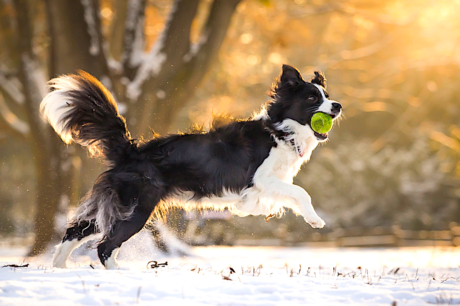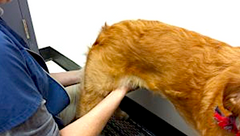
Learn why osteopathy alleviates pain, restores freedom of movement and enhances the body’s innate healing abilities after routine surgeries.
Osteopathy is a system of medicine based on manual manipulation. It alleviates pain, restores freedom of movement and enhances the body’s innate healing abilities. Though people often assume osteopathy is similar to chiropractic, it’s actually a whole body approach that considers fascia, viscera, vascular and lymphatic flow, and is not exclusively focused on the spine and joints. While it is a newer modality in the world of integrative and holistic veterinary treatments, osteopathy has, for me, been revolutionary in getting to the “why” of many musculoskeletal conditions, and has resolved many mobility issues in dogs, cats and horses.
I became certified in veterinary chiropractic in the mid-1990s, and over the following 15 years my small animal and equine practice consisted of 100% chiropractic and acupuncture. The majority of my cases then and now have been neurologic/musculoskeletal conditions. Over the years, I began studying osteopathy in the form of human craniosacral therapy and human visceral manipulation, and later took extensive training in equine osteopathy. I adapted what I learned on other species to treat dogs and cats. Along the way, I made some remarkable discoveries of my own concerning the deep underlying causes of certain mobility issues in small animals.
Conditions commonly treated by osteopathy include lameness, back or neck pain, arthritis, ACL (CCL) injuries, prevention of ACL tears, lumbar/thoracolumbar disc disease, iliopsoas muscle strain, spondylosis, lumbosacral stenosis, Wobbler syndrome, urinary incontinence, lick granulomas and common mobility issues in older dogs/cats (stiffness, hind end weakness, loss of normal physical activity). I also see canine athletes to improve their performance and prevent injuries, as well as puppies and litters of puppies to address alignment and joint freedom very early on.
The 3 pillars of osteopathy
1. Visceral manipulation (visceral osteopathy)
Fascia, including the ligaments that tether organs to other internal structures, can become excessively tight from trauma, surgery or inflammation. An adhesion is tissue that has lost its normal gliding movement with any surrounding tissue. This form of excessive tension can change autonomic nerve flow back to the spine (via gamma interneurons), which causes rotation and reduced mobility in the sacrum (if pelvic viscera is involved) and can also cause two to three vertebrae to fixate as a group. When the tight fascia is released, these previously restricted bones automatically become free on their own without direct intervention. This leads to a longer-term correction than a manipulation of these particular joints.
In addition to “tight” organs, organ dysfunction or pathology can also have an influence on altered autonomic nerve flow back to the spine. When health returns to the affected organ, the altered autonomic nerve flow will return to normal and will be reflected in restored normal range of motion in the affected joints.
Osteopathic principles regard the importance of the afferent nerve flow (from the organ back to the spinal vertebrae and cord) as well as the influence of the efferent autonomic nerve flow (nerve flow going from the spinal cord to the organs).
The goal of visceral manipulation is to release excessive mechanical tension around any organ, thus improving mobility, nerve function and blood/lymph flow in the area. Techniques include direct, gentle mobilization and more passive “listen and follow” fascial releases.
|
|
Visceral manipulation of the bladder ligaments to release the spay surgery adhesion (normalizes autonomic nerve tone to the sacrum and upper lumbar vertebrae). |
While chiropractic and other manipulative techniques can help when joint restriction is truly local, at least 50% of joint restrictions in the spine, pelvis and shoulders can originate from organ issues (too tightly attached or not working at 100%). If a bone (sacrum, vertebra, scapula) has lost its normal motion from a visceral cause, addressing the internal visceral issue will lead to automatic release of the joint restriction without the need for any local treatment.
2. Joint manipulation
The purpose of an adjustment/manipulation is to restore normal range of motion to the joint (spinal, extremity or rib) through normalizing local neurologic reflex loops (by interrupting irritated gamma and alpha motor neurons and restoring normal afferent stimuli). This inhibits local spinal muscle spasms that are maintaining the restriction in the joint. Other benefits include the release of local adhesions in the joint, restoring local circulation, and decreasing local or referred pain. Two techniques are used:
- Direct techniques – These go into the direction of the barrier or “stuck-ness” and include osteopathic slow, long lever manipulations or short lever, high velocity, low amplitude thrusts (HVLA) (similar to some chiropractic techniques).
- Indirect techniques or functional indirect techniques – These techniques move away from the restriction barrier to the “side of ease”. This is a more individualized way to release a joint; it involves “listening” to where all the tissues want to go in three dimensions, and then slowly following these unique unwinding movements until there is a complete release of the entire joint, including all surrounding soft tissues.

|
Checking sacro-pelvic symmetry/balance. |
Joint restrictions are “neurologically mediated” from two different causes. The first cause is local to the joint itself (from trauma, repetitive strain, stress) and is resolved via a direct manipulation (chiropractic, osteopathic, etc.). The second cause occurs via altered autonomic nerve flow from an organ issue. Resolving the organ issue (adhesion, dysfunction) will cause the joint(s) to automatically normalize on its/their own.
3. Craniosacral therapy (CST)
CST addresses not only increased mechanical tensions in the dural tissues of the central nervous system, but also fascial strain patterns anywhere in the body, including the thoracic and abdominal cavities, visceral ligaments, and fascia around joints. Intense physical activity and trauma (slips, falls, extreme play) can cause increased tensions in internal fascial tissue, and the respiratory diaphragm, etc., that can be released via CST. An indirect light touch technique (5 grams of pressure, or the weight of a nickel) encourages the self-correcting mechanisms of the body to release abnormal tensions.
Osteopathy in practice – observations related to spay/neuter
Over the last decade, I have made three significant observations – all related to routine spay/neuter:
1: Routine spay/neuter surgeries cause a sacro-iliac (SI) fixation in all dogs, cats and horses. This reduces normal motion and power in the hind end, setting them up for future mobility problems. Quadrupeds are “rear wheel drive” creatures so it is all about maintaining full power in the hind end for as long as possible. Mechanical issues (non-visceral) can also be going on in the sacro-pelvic region (which is why chiropractic can help with hind end issues); however, the spay/neuter influence will always have more significant impact due to the young age at which these surgeries are done. This loss of symmetrical freedom and mobility in the hind end is not noticed at this age, and many animals adapt to it for several years until they no longer can.
2: ACL (CCL) injuries/tears can be potentially prevented if early treatment of spay/neuter adhesions are addressed to normalize SI movement. The fibula is involved in this pattern of susceptibility.
3: Front end lameness is often directly related to an SI fixation in the pelvis on the same side, and can be a stubborn problem to treat. We truly need to look at the whole dog/cat in these cases.
How spay/neuter adhesions restrict mobility in dogs and cats
As I summarized above, spay/neuter can affect mobility in three ways:
1. Sacro-iliac fixations
The mild fascial adhesion created subsequent to routine spay/neuter surgery causes a subtle loss of normal mobility at the level of the distal bladder (ligaments of the bladder lose their full motion by only a few millimetres). This changes afferent autonomic nerve flow (sympathetic and parasympathetic) to the sacrum and to the first and second lumbar vertebrae, causing them to rotate/lose normal mobility. The sacro-iliac joint restriction (sacral rotation and ilium rotation) involves loss of normal SI motion on one side only. In osteopathic language, this is often referred to as a “dorsal inflair” of the ilium (same as “PI” – Posterior Inferior ilium in chiropractic terminology). For my clients, I call it “Crooked Butt Syndrome” to relay the idea that there is no longer symmetry in how the animals use their bodies. This pelvic crookedness is the basis of the commonly-noticed “side winding” or “crabbing” gait. There are both short lever (chiropractic) and long lever motion tests to find which SI joint is affected, but I find the long lever (hind limb abduction or “pee on a tree”) test more accurate.
Lumbar 1 and 2 restrictions are in a lateral side-bending pattern and both to the same side. This restriction pattern is often in extension and feels “softer” than a typical vertebra restricted in flexion that is easy to palpate and release with chiropractic manipulation (like a lower thoracic vertebra). Lumbars 1 and 2 lose their mobility due to direct ANS influence (afferent sympathetic flow) and automatically return to normal motion when the adhesion around the bladder is released. Improving the motion of Lumbars 1 and 2 by treating spay/neuter adhesions can significantly help dogs with thoracolumbar disc disease and back pain, and probably prevent some cases as well.
Direct, gentle mobilization and release of the spay/neuter adhesion will resolve the rotated sacrum/ilium and lumbar restrictions immediately, without actually having to go to those osseous structures directly. It takes one to three treatments (a week or more apart) to permanently resolve spay/neuter adhesions. I am a strong advocate for spaying/neutering (although not pre-pubertal); however, in an “ideal” world, veterinarians would know to treat these adhesions soon after surgery.
Other visceral causes of sacropelvic/lumbar restrictions include congestion of the prostate in intact male dogs. and adhesions from severe cystitis, cystotomy, C-section, and hormonal imbalance in some bitches.
2. ACL (CCL) injuries / tears
At any given time, 30% or more of my patients are dogs with ACL issues. I discovered that the side of surgical repair (in the first knee) and the side of SI restriction from the earlier spay/neuter surgery were correlated almost 100% of the time. The early SI restriction causes a subtle loss of motion at the area of the distal fibula/calcaneal-tarsal joint on the same limb. This leads to a loss of subtle motion at the proximal fibula near the stifle and an early mild laxity of the ACL. No lameness occurs with this very mild laxity. It is like a “pre-pre” positive drawer sign — in a joint that has had no damage. Yet this laxity is reversible to 100% tightness when the normal motion of the fibula is restored. It is an immediate change mediated by what I think is some local neurological reflex between the fibula and the stifle joint.
It is my belief that this treatment could be highly preventive of future ACL injuries since the early, reversible laxity can be a form of weakness in the ligament, which sets it up for a potential future tear. In dogs that already have a partial ACL tear, treating the fibula/tarsus still addresses some laxity and can help joint stability. Restoring normal SI motion strengthens the hind end with or without surgical repair of the ACL. By restoring power to the hind end in dogs that have an ACL issue in the first knee, it’s possible to prevent the second knee from getting a future ACL injury. My clients who have “ACL-prone” breeds bring in their young dogs for early treatment of the spay/neuter adhesion and to normalize the biomechanics of the affected limb. The potential is always there to actively prevent a devastating ACL problem. I agree with recent epidemiologic research that there is a greater incidence of ACL issues in spayed/neutered dogs, but I believe the true cause has more to do with this abnormal mechanical influence of the SI joint to the fibula rather than to the loss of hormones from surgery.
3. Front end lameness
The dura mater around the brain and spinal cord are firmly attached at only the pelvis and skull, so excessive tension at one end is relayed directly to the other end on the same side. When the SI joint gets restricted (from either a mechanical or visceral cause), there is a corresponding reciprocal restriction in the temporal bone on the same side. Along with that comes an upslip (dorsal/ventral) restriction in the scapula (via the brachycephalicus muscle connecting the skull to the humerus). I see an almost 100% correlation between the side of front end lameness and SI restriction from earlier spay/neuter adhesion.
When the SI restriction is resolved (via treating either the visceral or local mechanical cause), normal mobility automatically returns to the scapula. This truly shows the fascial continuity of the body. In the front-end lameness cases that do not respond to other approaches (conventional, chiropractic, acupuncture, physio/rehab) I have had excellent results in many patients by directly restoring normal scapular movement via the treatment of pelvic viscera. Once the scapula is moving normally up and down, the previous soft tissue lesion causing the pain/lameness can actually heal.
All spayed/neutered dogs and cats have a scapular upslip on one side, but not all become lame in that limb. The susceptibility for future pain/lameness will always exist on that side since the loss of ideal scapular motion is a set-up for potential soft tissue strain in the shoulder area. These local soft tissue pathologies are commonly found by rehab/physio/orthopedic-oriented vets but often these practitioners do not find the underlying reason for the strain pattern since it often exists at the other end of the body (SI joint, viscera). Also, since quadrupeds do not have a clavicle when the scapula loses its normal dorsal-ventral motion, the lower cervical vertebrae are directly affected, which sets up animals for neck issues (stiffness, lameness, referred nerve issues such as lick granulomas, etc.).
Conclusion
Visceral osteopathy seems magical at times. Treating spay/neuter adhesions has literally revolutionized my practice. It is very empowering to get at the root of mobility issues very quickly in dogs and cats, and see long-lasting, efficient responses in just a few treatments, often leading to a permanent cure of lameness or musculoskeletal pain. Having treated older dogs and cats for 20 years, I know what I am also preventing if I see them when they’re younger and get the chance to restore symmetry and balanced mobility early on.
Videos of the osteopathic exam and treatment of the spay/neuter issue can be viewed at TaylorHolisticVet.ca/video.
Author: Laura Taylor, DVM
Link: https://ivcjournal.com/osteopathy-mobility-surgeries/
References
Barral, Jean-Pierre. Visceral Manipulation (revised ed). Seattle: Eastland Press, 2007.
Barral, Jean-Pierre. Visceral Manipulation II. Seattle: Eastland Press, 1989
Barral, Jean-Pierre, Croibier, Alain. Trauma: An Osteopathic Approach. Seattle: Eastland Press, 1997.
Becker, Rollin. The Stillness of Life. Portland: Stillness Press, 2000.
Becker, Rollin. Life in Motion. Portland: Stillness Press, 1997.
Budras, Klaus-Dieter. Anatomy of the Dog. Hannover: Schlutersche, 2007.
Chaitow, Leon. Fascial Dysfunction: Manual Therapy Approaches. Edinburgh: Handspring Publishing, 2014.
Felten, David, Jozefowicz, Ralph. Netter’s Atlas of Human Neuroscience. Teterboro Icon Learning Systems, 2003.
Kern, Michael. Wisdom in the Body. The Craniosacral Approach to Essential Health, Berkeley: North Atlantic Books, 2005.
Paoletti, Serge. The Fasciae: Anatomy, Dysfunction and Treatment. Seattle: Eastland Press, 2006.
Schleip, Robert et al. Fascia: The Tensional Network of the Human Body. Churchill Livingstone Elsevier, 2012.
Schwind, Peter. Fascial and Membrane Technique. Churchill Livingstone Elsevier, 2006.
Stone, Caroline. Visceral and Obstetric Osteopathy. Churchill Livingstone Elsevier, 2007.



